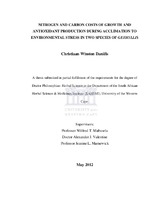| dc.description.abstract | Gethyllis multifolia L. Bolus and G. villosa Thunb. are winter-growing, summerblooming,deciduous and bulbous geophytes that grow naturally in the semi-arid succulent Karoo biome of South Africa. Both species grow under full sun conditions and have four distinctive growth phases: a winter (cold and wet) growing phase, leaf senescence phase towards spring, flowering phase during the hot and dry summer months, and fruit and leaf formation phase in autumn. The medicinal uses of this genus (including G. multifolia “Kukumakranka” and G.villosa “hairy kukumakranka”) range from cures for colic, digestive disturbances,teething problems, fatigue, boils, bruises and insect bites, to being used as an aphrodisiac. Gethyllis multifolia is threatened in its natural habitat and is listed in the ‘Vulnerable’ category of the ‘Red Data List of Southern African Plants’ and the ‘IUCN-World Conservation Union List of Plants’. The literature indicate that the habitats of both species are being exposed to drier conditions and is further threatened by the encroachment of invasive indigenous plant species. It is not known to which extent these factors may pose a threat to the existence of both species. The first objective of this investigation was to determine the costs of vegetative and reproductive growth during the seasonal life cycle of the plant, using carbon(C) and nitrogen (N) as a physiological currency. The second objective was to elucidate a functional basis to explain the difference in the conservation status of both species in their natural habitat. Both species were subjected to drought and shading as environmental stresses and the plant physiological performance was investigated via photosynthetic gas exchange. The third objective of the study was to evaluate the antioxidant content (total polyphenol, flavonol/flavone and flavanone content) and antioxidant capacity [ferric reducing antioxidant power (FRAP), oxygen radical absorbance capacity (ORAC) and 2,2'-azino-di-3-ethylbenzthiazoline sulphonate (ABTS) radical cation scavenging ability] of natural populations and plant samples that were exposed to photo-and-drought environmental stresses. This study was done to elucidate the antioxidant profile of plant parts of natural populations as well as providing farmers, traditional healers and pharmaceutical companies with cultivation environmental conditions to enhance the antioxidant properties of the species. This investigation also attempted to isolate and characterize, by means of thin-layer chromatography (TLC) and column chromatography (CC), natural compounds from both species to lend support to the purported antioxidant benefit of both species and to further lend support to claims made by traditional healers of the medicinal potential of the genus. This study, however, did not engage in any in vivo studies or human trials to support published literature of the medicinal benefits of the genus. | en_US |

